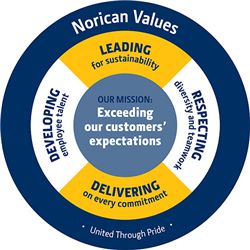The transition to electric cars presents opportunities to the light metal industry, but not without challenges. As e-mobility reaches its lift-off point, how can light metal casting producers get ready?
The automobile industry is experiencing a strong trend towards electromobility. The figures and deadlines given vary, but as of 2025, the industry expects a considerable increase in the number of electric vehicles registered. The market penetration of electric cars will also cause a considerable increase in the use of light metal castings. These reduce the weight of the vehicle, thus increasing the distances which can be achieved. For this reason, the imminent structural change is a growth opportunity for the aluminium casting industry. The approach pursued by the plant manufacturers? To stay competitive, you have to keep the costs per casting down.
And not only the automotive manufacturers are experiencing a structural change at present – its suppliers are too. The subject of electromobility is becoming more and more relevant all the time. It is considered as certain that the industry for electric cars will experience an enormous upswing by 2025 at the latest. This development means new opportunities for the light metal casting industry: to ensure longer distance ranges and offer more reasonably priced batteries for electric vehicles, you have to have less weight – and consequently lightweight components.
Plant manufacturers under obligation
In the traditional manufacture of aluminium castings, about 65 percent of all costs are created by the metal used (the metal loss in the foundry has already been taken into account here). Another 15 percent of costs are allocated to energy consumption, and at least half of this is for melting the metal and holding the melt at the necessary temperature. Another 15 percent are accounted for by the investment costs for the systems themselves. This means that plant manufacturers in particular have a crucial influence on the costs per casting. “If we want to be one of the winners of the structural change, it’s up to us to provide the necessary solutions,” Rudi Riedel confidently explains. The manager of StrikoWestofen, manufacturer of thermal process technology with its headquarters in Gummersbach, promptly defines a whole series of influential factors: user-friendly products, automation solutions, in-depth consultancy for system design as well as process optimization, a faster return on investment (ROI) and a strong international presence with consistent service and product quality – these are just a few of the fields in which plant manufacturers need to provide solutions.
Future-proof technology today
To be able to produce light metal castings economically with high quality, you need systems that are “of a piece”. The focus is on melting and holding as well as heat treatment. The StrikoWestofen concept aims at ensuring a high availability of the overall process while also taking the optimization of individual process steps into account. For the field of melting, for instance, this means increasing the metal yield. Here the company relies on targeted temperature and flow control, state-of-the-art burner technologies as well as minimized excess air. The manufacturer has also optimized the energy efficiency of its “StrikoMelter” melting furnaces by incorporating the use of the waste air. In the field of dosing, too, the subjects of metal yield and energy efficiency are focused on in addition to dosing accuracy and process reliability. The corresponding products – like the dosing furnace “Westomat”, or the melt transport system “Schnorkle” – are therefore designed as closed systems in which the melt is removed below the surface of the bath.
In the production of aluminium castings for electric cars, special attention is paid to the final heat treatment. Here the starting point for StrikoWestofen is the holistic consideration of the process so that all necessary steps can be precisely coordinated. Progressive automation of all processes is to make sure that capacities are used optimally at all times, allowing savings to be made with regard to time, energy and personnel. “Affordability is still the watchword,” says Riedel, summing up. “As long as components made of cast aluminium or magnesium are not only a convincing proposition in terms of quality but remain affordable too, we see an opportunity and not a risk in the strong growth of electromobility.” The company recently put its optimism on show: an electrically driven company car is now parked in the grounds of the Gummersbach headquarters at an electric filling station of its own.
More details on future-proof technologies for light metal casting are available directly from StrikoWestofen via e-mail or by telephone (+49 (0)2261-70910).

